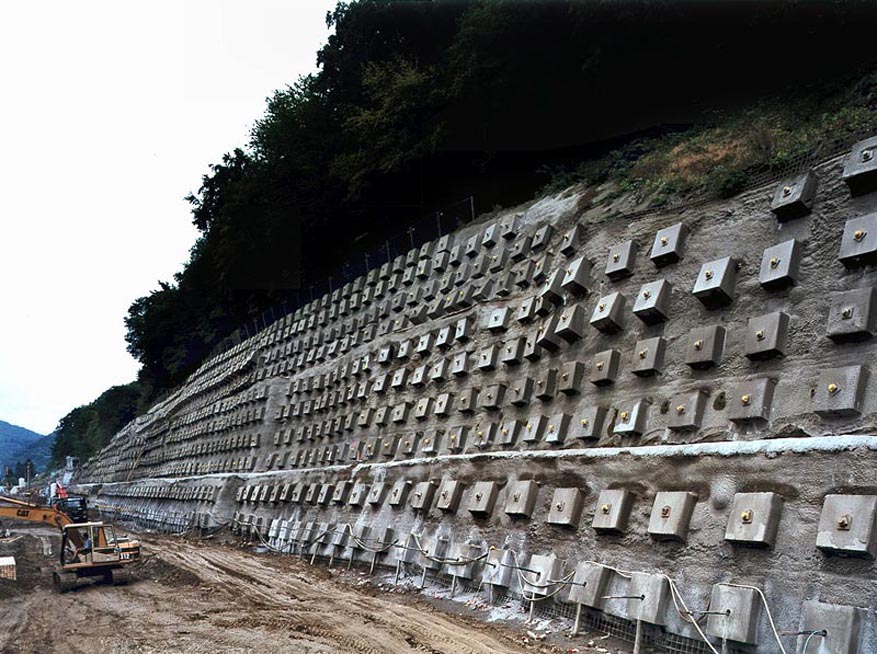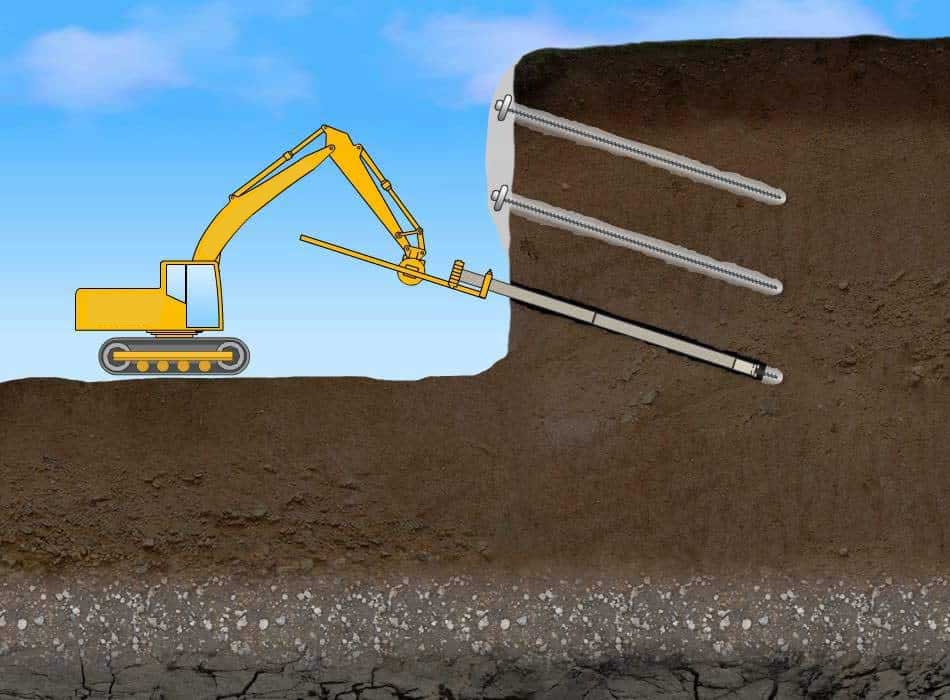Soil nailing is a soil stabilization technique that involves reinforcing soil by installing closely spaced steel or fiberglass elements called nails or rods into the ground at a shallow angle, typically between 10 to 20 degrees from horizontal. The nails are usually grouted into the soil to create a composite material that improves the soil’s shear strength and stability. Soil nailing is commonly used to stabilize slopes, excavations, and retaining walls in construction projects. It is a cost-effective and efficient method for providing lateral support and can be used in a wide range of soil conditions.
It is an effective technique for increasing soil stability and can be used to reinforce slopes, excavations, retaining walls, and other structures. The suitability of soil nailing as a stabilization method depends on several factors, including the soil conditions, the availability and feasibility of other stabilization methods such as ground anchors or geosynthetic materials, and the overall cost of the project.
It is worth noting that soil nailing is most effective when used on slopes above the groundwater table. Groundwater can significantly affect the soil’s stability and can undermine the effectiveness of soil nailing as a stabilization method. Therefore, before deciding to use soil nailing, a thorough analysis of the soil and groundwater conditions should be conducted to ensure that it is a suitable solution for the specific project.
Soil nail walls are typically constructed from the top down, with steel bars or nails being installed at a shallow angle into the soil to reinforce it and increase its stability. The soil nailing technique gets its name because the steel bars or nails used in the process are similar to nails being driven into wood.
It is often used to prevent landslides or to stabilize slopes or embankments where the natural soil conditions are not sufficient to provide adequate stability. By installing steel bars or nails, the soil’s shear strength is increased, reducing the likelihood of slope failure or landslides. Soil nailing is a cost-effective and efficient method of soil stabilization that can be used in a wide range of soil types and conditions.

Advantages of Soil Nailing
- Cost-effective: It is often more cost-effective than traditional soil stabilization methods, such as retaining walls or ground anchors, particularly in situations where access is limited or space is restricted.
- Versatility: It can be used in a wide range of soil types and conditions, including soft soils, hard soils, and rock formations.
- Minimal disruption: It requires minimal excavation and disruption to the surrounding area, making it a less invasive and less disruptive stabilization method.
- Rapid construction: It can be installed quickly, reducing the construction time and overall project schedule.
- Increased safety: It provides increased stability and safety for structures, roads, and slopes, reducing the risk of failure and potential harm to people and property.
- Aesthetics: It can be designed to blend in with the surrounding environment, reducing the visual impact of stabilization works.
- Sustainability: It can be used as part of a sustainable construction approach, reducing the need for concrete or other construction materials and minimizing the environmental impact of the project.
Application of Soil Nailing
- Slope stabilization: It can be used to stabilize slopes that are at risk of failure due to natural or man-made factors, such as erosion, weathering, excavation, or construction activities.
- Retaining walls: It can be used to reinforce retaining walls, particularly in situations where space is limited, or traditional retaining wall construction methods are not feasible.
- Excavations: It can be used to stabilize excavations, particularly in situations where the excavation is deep or the soil conditions are unstable.
- Bridge abutments: It can be used to reinforce bridge abutments and other foundation structures, providing increased stability and preventing settlement or failure.
- Landslide repair: It can be used as a repair technique to stabilize landslides or to prevent future landslides from occurring.
- Tunneling: It can be used to reinforce the ground around tunnels, providing increased stability and preventing settlement or collapse.
- Roadway embankments: It can be used to reinforce roadway embankments, particularly in situations where space is limited or traditional embankment construction methods are not feasible.

Limitations of Soil Nailing
- Depth limitations: It is generally limited to depths of around 30 meters (100 feet) or less, depending on the soil conditions and other factors. For deeper soil stabilization, other methods, such as ground anchors, may be required.
- Soil type limitations: It is most effective in cohesive soils or rock formations. In non-cohesive soils, such as sands and gravels, soil nailing may not be effective, and other stabilization methods may be required.
- Groundwater limitations: It may not be effective in groundwater conditions, as water can weaken the soil and compromise the stability of the installation.
- Space limitations: It requires access to the soil surface, which may not always be possible in situations where space is restricted or the soil is located in hard-to-reach areas.
- Durability limitations: It relies on the strength of the soil and the integrity of the steel bars or nails. Over time, the steel can corrode, and the soil can settle, reducing the effectiveness of the stabilization.
- Design limitations: It requires careful design and engineering to ensure that it is effective and safe. Poor design or installation can compromise the stability of the soil and pose a risk to people and property.
Types of Soil Nailing
There are several types of soil nailing, including:
- Passive soil nailing: This is the simplest type of soil nailing, which involves installing steel bars into the soil without any grout or other reinforcing materials. The steel bars are typically placed at a downward angle, with a slight horizontal offset to increase stability.
- Active soil nailing: This type of soil nailing involves injecting grout or another reinforcing material into the soil around the steel bars to increase their bonding strength and improve overall stability. Active soil nailing is typically used in more challenging soil conditions or for higher load-bearing structures.
- Combination soil nailing: This type of soil nailing combines both passive and active soil nailing techniques, using steel bars and grout to provide maximum stability in difficult soil conditions.
- Temporary soil nailing: This type of soil nailing is used for short-term stabilization, such as during construction activities. Temporary soil nailing typically uses shorter steel bars and a less extensive installation process than permanent soil nailing.
- Top-down soil nailing: This type of soil nailing involves installing steel bars from the top of the slope or excavation and working downwards. Top-down soil nailing is typically used in situations where access is limited or space is restricted.
- Bottom-up soil nailing: This type of soil nailing involves installing steel bars from the bottom of the slope or excavation and working upwards. Bottom-up soil nailing is typically used in situations where the top of the slope or excavation is unstable or at risk of collapse.
Conclusion
Soil nailing is a versatile and effective soil stabilization technique that uses steel bars or nails to reinforce the soil and enhance its stability. It is a cost-effective and durable solution that can prevent landslides, stabilize slopes, and provide long-term stability for various structures. However, careful design and installation are essential, and soil nailing has certain limitations and potential drawbacks. Overall, it is a valuable tool in geotechnical engineering for ensuring the safety and stability of structures built on or near unstable soil conditions.


